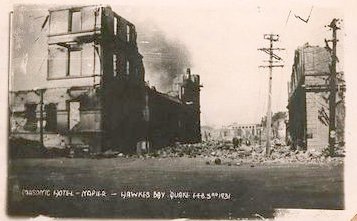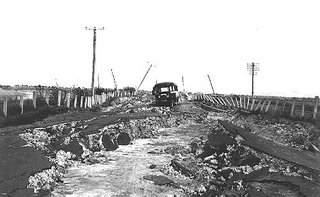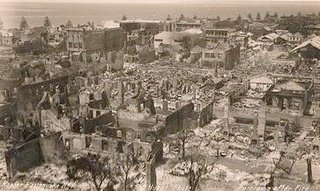
A fire swept through both towns immediately after the quake. The fire apparently started in a chemist’s shop in Napier, which was in close proximity to flammable liquids. The flames spread quickly and had, within hours, bridged the distance between Napier and Hastings. The Fire Department in Napier was at a loss to control the blaze as a result of losing their water supply. The water supply in Hastings, however, was still operable, allowing them to fight back against the fire. Still the flames spread and had soon spread further to the nearby township of Ahuriri.

The force of the earthquake destroyed many of the city’s famous landmarks. Chunks of the coastline were dislodged and thrown into the sea. Napier’s Bluff Hill, a popular tourist spot, was completely destroyed and thrown into the waters below. The upward thrust of the quake also managed to empty the waters of the Ahuriri Lagoon, a wide stretch of water a few kilometres from Napier. The result of this was that 9,000 acres of dry land were made available in a matter of minutes.

The long term effects on the Napier landscape were quite substantial. The whole area tilted upwards by about seven feet. 2230 hectares were raised to sea level. Most of the major buildings in the city were completely destroyed. Roads and communications acsoss the whole area were cut. It just so happened, however, that the Royal Navy Ship, HMS Veronica, was docked at the Port of Napier. So, it was by way of the Ship’s radio that the rest of New Zealand was notified of the calamity. People were afraid to enter their homes for days and found accommodations at the local Motor Camp or on the beach. Their were about 150 aftershocks in the 24 hours after the main shock. Over the next two weeks, there would be 525 such aftershocks.

Napier City has truly proved to be a phoenix rising from the ashes. Architects were brought into the city to plan a new city with a new look. Out went the staid Victorian look of former times and in came a modern new art deco style. The newest styles of the 1930’s were incorporated in the building designs, from Stripped Classical to Spanish Mission. But it was the Art Deco look that prevailed. The city’s brand new look was accentuated with by rows of palm trees and the unique Norfolk Island pine. Napier has since become famous as a little piece of European design down under.
pictures from www.kiwiherald.com

2 comments:
Only recently we saw a
documentary film- The
Greatest Earthquake in San
Francisco- 1906.
How (some) people survive such
a Global Disaster is amazing,
LOVEN IT, GOOD FACTS AND WILL NOW USE THEM FOR SCHOOL WORK, OVER 1000 WAYS TO SAY HOW GOOD IT IS. WELL DONE TO KEE-WEE
FRIENDLY
Post a Comment